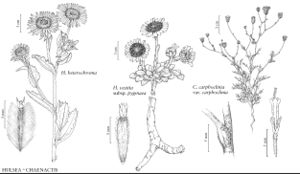Hulsea
in War Department[U.S.], Pacif. Railr. Rep. 6(3): 77, plate 13. 1858 ·.
| Taxon | Illustrator ⠉ | |
|---|---|---|
 | Hulsea vestita subsp. pygmaea Chaenactis carphoclinia var. carphoclinia Hulsea heterochroma | Yevonn Wilson-Ramsey Linny Heagy Yevonn Wilson-Ramsey |
Annuals or perennials, 5–150 cm. Stems erect, simple or branched (aerial shoots often from subterranean caudices). Leaves basal or basal and cauline, proximally whorled, distally alternate; petiolate (at least basal) or sessile; blades mostly lance-linear, oblanceolate, ovate, or spatulate, margins entire, lobed, or toothed, faces thinly lanate to densely woolly (hairs crisped, tangled, or matted, usually 0.8+ mm) and/or glanddotted, glandular-puberulent, glandular-villous, or stipitate-glandular. Heads radiate, borne singly or in corymbiform arrays. Involucres obconic to hemispheric, 8–26 mm diam. Phyllaries persistent, 14–35 (–60+) in 2–4 series (reflexed in fruit, mostly lanceovate to lanceolate or linear, herbaceous). Receptacles flat, knobby or pitted, epaleate. Ray-florets 9–60+, pistillate, fertile; corollas yellow, orange, or red. Disc-florets 20–200+, bisexual, fertile; corollas yellow to orange (glabrous or sparsely hairy), tubes shorter than or about equaling cylindric throats, lobes 5, deltate to lanceovate. Cypselae clavate to linear, compressed (lenticular in cross-section), silky-hairy; pappi of 4 (distinct) quadrate to spatulate, equal, subequal, or unequal, erose to laciniate scales (the alternate alike). x = 19.
Distribution
w United States, nw Mexico
Discussion
Species 7 (7 in the flora).
Selected References
Lower Taxa
Key
| 1 | Basal and proximal cauline leaves gray to grayish green, lanate to woolly (hairs mostly eglandular) | > 2 |
| 1 | Basal and proximal cauline leaves ± green, mostly glandular-puberulent or glandular villous (sometimes sparsely lanate as well, sometimes woolly in H. nana) | > 3 |
| 2 | Leaves basal and cauline, blades broadly oblanceolate to spatulate, 6–10 cm; heads 2–5; cypselae 4–6 mm | Hulsea californica |
| 2 | Leaves mostly basal, blades spatulate, 1–9 cm; heads 1–2; cypselae 5–10 mm | Hulsea vestita |
| 3 | Leaves mostly basal (cauline none or relatively few); heads 1–2 (per basal leaf rosette) | > 4 |
| 3 | Leaves mostly cauline (basal usually present as well); heads 3–5 | > 5 |
| 4 | Plants (10–)20–40 cm; leaf margins sinuate, lobed, or toothed (lobes or teeth mostly triangular); phyllary apices acute to attenuate; ray florets 28–59 | Hulsea algida |
| 4 | Plants 5–15(–20) cm; leaf margins lobed (lobes mostly oblong); phyllary apices acuminate to acute; ray florets 12–30 | Hulsea nana |
| 5 | Ray laminae red to reddish purple (narrowly oblong to linear, ciliate) | Hulsea heterochroma |
| 5 | Ray laminae yellow (narrowly elliptic to narrowly lance-oblong) | > 6 |
| 6 | Ray florets 10–23, corolla tubes hairy | Hulsea brevifolia |
| 6 | Ray florets 20–35, corolla tubes glabrous | Hulsea mexicana |